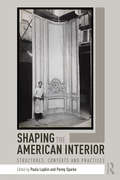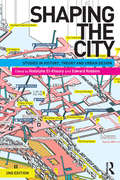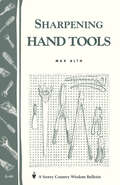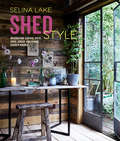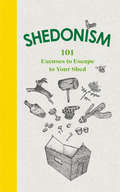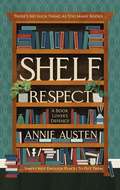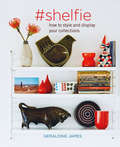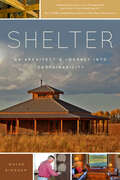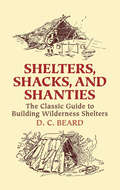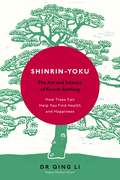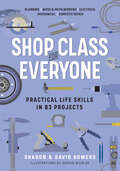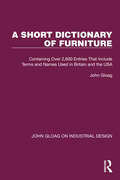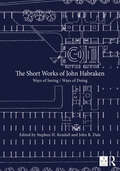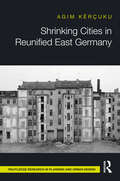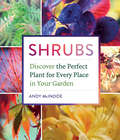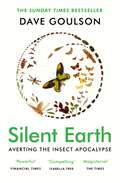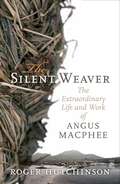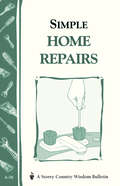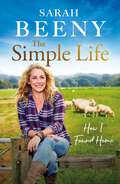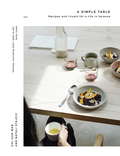- Table View
- List View
Shaping the American Interior: Structures, Contexts and Practices
by Paula Lupkin Penny SparkeBringing together 12 original essays, Shaping the American Interior maps out, for the first time, the development and definition of the field of interiors in the United States in the period from 1870 until 1960. Its interdisciplinary approach encompasses a broad range of people, contexts, and practices, revealing the design of the interior as a collaborative modern enterprise comprising art, design, manufacture, commerce, and identity construction. Rooted in the expansion of mass production and consumption in the last years of the nineteenth century, new and diverse structures came to define the field and provide formal and informal contexts for design work. Intertwined with, but distinct from, architecture and merchandising, interiors encompassed a diffuse range of individuals, institutions, and organizations engaged in the definition of identity, the development of expertise, and the promotion of consumption. This volume investigates the fluid pre-history of the American profession of interior design, charting attempts to commoditize taste, shape modern conceptions of gender and professionalism, define expertise and authority through principles and standards, marry art with industry and commerce, and shape mass culture in the United States.
Shaping the City: Studies in History, Theory and Urban Design
by Rodolphe El-Khoury Edward RobbinsTaking on the key issues in urban design, Shaping the City examines the critical ideas that have driven these themes and debates through a study of particular cities at important periods in their development. As well as retaining crucial discussions about cities such as Los Angeles, Atlanta, Chicago, Detroit, Philadelphia, and Brasilia at particular moments in their history that exemplified the problems and themes at hand like the mega-city, the post-colonial city and New Urbanism, in this new edition the editors have introduced new case studies critical to any study of contemporary urbanism – China, Dubai, Tijuana and the wider issues of informal cities in the Global South. The book serves as both a textbook for classes in urban design, planning and theory and is also attractive to the increasing interest in urbanism by scholars in other fields. Shaping the City provides an essential overview of the range and variety of urbanisms and urban issues that are critical to an understanding of contemporary urbanism.
Shaping the City: Studies in History, Theory and Urban Design
by Rodolphe El-Khoury Edwards RobbinsTaking on the key issues in urban design, Shaping the City examines the critical ideas that have driven these themes and debates through a study of particular cities at important periods in their development. As well as retaining crucial discussions about cities such as Los Angeles, Atlanta, Chicago, Detroit, Philadelphia, and Brasilia at particular moments in their history that exemplified the problems and themes at hand like the mega-city, the post-colonial city and New Urbanism, in this new edition the editors have introduced new case studies critical to any study of contemporary urbanism – China, Dubai, Tijuana and the wider issues of informal cities in the Global South. The book serves as both a textbook for classes in urban design, planning and theory and is also attractive to the increasing interest in urbanism by scholars in other fields. Shaping the City provides an essential overview of the range and variety of urbanisms and urban issues that are critical to an understanding of contemporary urbanism.
Sharpening Hand Tools: Storey's Country Wisdom Bulletin A-66 (Storey Country Wisdom Bulletin)
by Max AlthSince 1973, Storey's Country Wisdom Bulletins have offered practical, hands-on instructions designed to help readers master dozens of country living skills quickly and easily. There are now more than 170 titles in this series, and their remarkable popularity reflects the common desire of country and city dwellers alike to cultivate personal independence in everyday life.
Shed Heaven
by Anna Groves National Trust BooksA celebration of some of Britain's most important and beloved buildings – its sheds. From the humble to the not so humble.
Shed Style: Decorating cabins, huts, pods, sheds and other garden rooms
by Selina LakeIn Shed Style, Selina Lake reveals how even the smallest garden can be home to an outdoor retreat.From the traditional gardener’s potting shed to a writer’s cabin to an artist's studio, Selina explores sheds, cabins, huts, greenhouses, pods and all manner of garden structures, providing ample inspiration for anyone dreaming of their own garden hideaway. She reveals how any existing shed, cabin or outbuilding can become a versatile work or social space rather than just somewhere to store the lawnmower. If you are short of space indoors, as so many of us are nowadays, a garden office, creative space, ‘she shed’ or work pod can provide a perfect solution. A greenhouse or potting shed will appeal to keen gardeners, while a cosy shepherd’s hut, perhaps with a bijou wood-burning stove, can work as guest accommodation. In Shed Style, Selina reveals how to create the shed of your dreams, presenting hundreds of fresh ideas for decorating and styling both the interior and exterior as well as suggestions for lighting, fabrics, furniture and other accessories. Shed Style is perfect for anyone who wants to make the most of their outdoor space.
Shedonism: 101 Excuses to Escape to Your Shed
by Ben WilliamsFind yourself, in your shed.Turn your she-shed or man cave into your own private escape with 101 simple, practical ideas.Take some well-deserved alone time and learn to preserve lemons and chillies, whittle a butter knife, tie your own fishing flies, keep chickens, plant a roof garden or make a camera obscura.Why not transform your shed itself? This book is full of inspiration for anyone who has dreamed of having an observatory, a sauna, a pub – or just a bit of peace and quiet at the bottom of the garden.The perfect gift for anyone who would rather be in their shed.
Shelf Respect
by Annie AustenDecluttering is all the rage, but what do you do when your preferred style of interior decor is miles of overstuffed bookshelves? If you can't bring yourself to KonMari your collection, SHELF RESPECT will validate your life choices.The perfect gift for the book lover in your life: a celebration of the humble but oh-so-wonderful bookshelf. Do you alphabetise your books or organise by genre... or (heaven forbid) colour? Have you merged your collection with your other half's? (And do you write your name inside the cover, just in case?) Do you keep all the books you've read, or only the most cherished? (Is there such a thing as too many books?) Are you a Billy aficionado, or are we talking library ladders and bespoke Oak shelves? Bound to provoke (good-natured) debate between Bibliophiles, SHELF RESPECT is a charmingly illustrated book in defence of towering TBR piles and overflowing shelves... no matter how you choose to organise them.
#shelfie: How to style and display your collections
by Geraldine JamesUse your shelves to display your collections and create ever-evolving works of art with Geraldine James’s inspirational ideas.Find out how you can use what you already have in a stylish and unexpected way to revitalise a room. Whether you want to group a collection of colourful vases against a dark wall, use picture rails to line up a selection of prints, or organise plants and treasured finds from the natural world, any shelf can be a stage for artful arrangements with this innovative guide. You can find a home for all your prized possessions, and the best thing about shelves is that you can change a display whenever the mood takes you. Chapter by chapter, discover ideas for how to arrange virtually anything and begin a journey into colour, textures and themes to create elegant focal points that give a home character and charm.
Shelter: An Architect's Journey into Sustainability
by Wayne BinghamAfter being trained and practicing conventional glass, steel, and concrete architecture for thirty years, an award-winning architect discovers the concept of sustainable living and embarks on a journey that ends with his own strawbale home at the foot of the Grand Tetons.
Shelters, Shacks, and Shanties: The Classic Guide to Building Wilderness Shelters
by D. C. BeardThis excellent hands-on guide by one of the founders of the Boy Scouts of America contains a wealth of practical instruction and advice on how to build everything from a bark teepee and a tree-top house to a log cabin and a sod house. No professional architects are needed here; and knowing how to use an axe is more important than possessing carpentry skills. More than 300 of the author's own illustrations and a clear, easy-to-follow text enable campers to create such lodgings as half-cave shelters, beaver mat huts, birch bark shacks, over-water camps, a Navajo hogan, and a pole house. <p><p> Additional chapters provide information on how to use an axe, split and notch logs, make a fireplace, and even build appropriate gateways to log houses, game preserves, ranches, and other open areas. An invaluable book for scouts, campers, hikers, and hunters of all ages, this guide and its fascinating collection of outdoor lore "still has intrinsic value," said Whole Earth Magazine, and will be of keen interest to any modern homesteader.
Shinrin-Yoku: The Art and Science of Forest Bathing
by Dr Qing LiShinrin = Forest Yoku = Bathing Shinrin-Yoku or forest bathing is the practice of spending time in the forest for better health, happiness and a sense of calm. A pillar of Japanese culture for decades, Shinrin-Yoku is a way to reconnect with nature, from walking mindfully in the woods, to a break in your local park, to walking barefoot on your lawn. Forest Medicine expert, Dr Qing Li's research has proven that spending time around trees (even filling your home with house plants and vaporising essential tree oils) can reduce blood pressure, lower stress, boost energy, boost immune system and even help you to lose weight. Along with his years of ground-breaking research, anecdotes on the life-changing power of trees, Dr Li provides here the practical ways for you to try Shinrin-Yoku for yourself.
Shop Class for Everyone: Plumbing · Wood & Metalwork · Electrical · Mechanical · Domestic Repair
by Sharon Bowers David BowersClear step-by-step instructions for everything you would have learned in shop class: woodwork, metalwork, wiring, and general home repair and maintenance, from how to hang a picture to how to replace a window pane. A stylish and easy-to-use home reference guide for today's DIYers, homeowners, new adults, and anyone who wants to be more self-sufficient at home.
A Short Dictionary of Furniture: Containing Over 2,600 Entries That Include Terms and Names Used in Britain and the USA
by John GloagOriginally published in 1952 but enlarged and revised in 1969, this dictionary became a standard authoritative work of reference. It contains 2,612 entries and over 1,000 illustrations, reproduced from contemporary sources and from drawings by Ronald Escott, Marcelle Barton and Maureen Stafford. The work is divided into 6 sections: the first and second concern the description and design of furniture, the third contains the entries, the fourth gives a list of furniture makers in Britain and North America, section five records books and periodicals on furniture and design and the concluding section sets out in tabular form the periods with the materials used, and types of craftsmen employed from 1100 to 1950.
A Short Dictionary of Furniture: Containing Over 2,600 Entries That Include Terms and Names Used in Britain and the USA
by John GloagOriginally published in 1952 but enlarged and revised in 1969, this dictionary became a standard authoritative work of reference. It contains 2,612 entries and over 1,000 illustrations, reproduced from contemporary sources and from drawings by Ronald Escott, Marcelle Barton and Maureen Stafford. The work is divided into 6 sections: the first and second concern the description and design of furniture, the third contains the entries, the fourth gives a list of furniture makers in Britain and North America, section five records books and periodicals on furniture and design and the concluding section sets out in tabular form the periods with the materials used, and types of craftsmen employed from 1100 to 1950.
The Short Works of John Habraken: Ways of Seeing / Ways of Doing (Open Building)
by Stephen H. Kendall John R. DaleThis book offers, for the first time, access to the chronological arc of John Habraken’s writing in a single collection. Few architects or scholars have so consistently and patiently pursued such a humane and culturally vital set of radical questions related to the behaviour of the built environment as N. John Habraken. From the publication of his first book in 1960, he has quietly helped redraw the map of architectural research, education, practice, design methods and theory. His insights lead us to a better understanding of how the built field works, contributing to the development of methods enabling professionals to contribute to its coherence and resilience. Following an introductory essay by the editors, placing Habraken’s work in context, this collection is organized in two sections and further organized around a number of specific themes: The Built Field; Role of the Architect; Control; Sharing Forms; Examples of Ways of Doing; Open Building; Tools; and Cultivating the Built Environment. A series of interviews with the author enable him to reflect on his journey of inquiry, research, advocacy and teaching – and the relationship between ways of seeing and ways of doing. Offering theoretical perspectives and methodological ways forward, this book will be of interest to architects, planners and urban designers tackling the challenges of the contemporary built environment that Habraken identifies, as well as educators and students.
The Short Works of John Habraken: Ways of Seeing / Ways of Doing (Open Building)
by Stephen H. Kendall John R. DaleThis book offers, for the first time, access to the chronological arc of John Habraken’s writing in a single collection. Few architects or scholars have so consistently and patiently pursued such a humane and culturally vital set of radical questions related to the behaviour of the built environment as N. John Habraken. From the publication of his first book in 1960, he has quietly helped redraw the map of architectural research, education, practice, design methods and theory. His insights lead us to a better understanding of how the built field works, contributing to the development of methods enabling professionals to contribute to its coherence and resilience. Following an introductory essay by the editors, placing Habraken’s work in context, this collection is organized in two sections and further organized around a number of specific themes: The Built Field; Role of the Architect; Control; Sharing Forms; Examples of Ways of Doing; Open Building; Tools; and Cultivating the Built Environment. A series of interviews with the author enable him to reflect on his journey of inquiry, research, advocacy and teaching – and the relationship between ways of seeing and ways of doing. Offering theoretical perspectives and methodological ways forward, this book will be of interest to architects, planners and urban designers tackling the challenges of the contemporary built environment that Habraken identifies, as well as educators and students.
Shrinking Cities in Reunified East Germany
by Agim KërçukuThe book explores the relationship between the shrinking process and architecture and urban design practices. Starting from a journey in former East Germany, six different scenes are explored in which plans, projects, and policies have dealt with shrinkage since the 1990s. The book is a sequence of scenes that reveals the main characteristics, dynamics, narratives, reasons and ambiguities of the shrinking cities’ transformations in the face of a long transition. The first scene concerns the demolition and transformation of social mass housing in Leinefelde-Worbis. The second scene deals with the temporary appropriation of abandoned buildings in Halle-Neustadt. The third scene, observed in Leipzig, shows the results of green space projects in urban voids. The scene of the fourth situation observes the extraordinary efforts to renaturise a mining territory in the Lausitz region. The fifth scene takes us to Hoyerswerda, where emigration and ageing process required a reduction and demolition in housing stock and social infrastructures. The border city of Görlitz, the sixth and last scene, deals with the repopulation policies that aim to attract retirees from the West.
Shrinking Cities in Reunified East Germany
by Agim KërçukuThe book explores the relationship between the shrinking process and architecture and urban design practices. Starting from a journey in former East Germany, six different scenes are explored in which plans, projects, and policies have dealt with shrinkage since the 1990s. The book is a sequence of scenes that reveals the main characteristics, dynamics, narratives, reasons and ambiguities of the shrinking cities’ transformations in the face of a long transition. The first scene concerns the demolition and transformation of social mass housing in Leinefelde-Worbis. The second scene deals with the temporary appropriation of abandoned buildings in Halle-Neustadt. The third scene, observed in Leipzig, shows the results of green space projects in urban voids. The scene of the fourth situation observes the extraordinary efforts to renaturise a mining territory in the Lausitz region. The fifth scene takes us to Hoyerswerda, where emigration and ageing process required a reduction and demolition in housing stock and social infrastructures. The border city of Görlitz, the sixth and last scene, deals with the repopulation policies that aim to attract retirees from the West.
Shrubs: Discover the Perfect Plant for Every Place in Your Garden
by Andy McIndoeThis problem‑solving guide—from one of the world&’s foremost woody plant experts—shows you everything you need to know to pick the right shrub for a wide variety of sites and conditions.
Silent Earth: Averting the Insect Apocalypse
by Dave Goulson'Compelling, penetrating, devastating - Silent Earth is a wake-up call for the world.' Isabella TreeInsects are essential for life as we know it. As they become more scarce, our world will slowly grind to a halt; we simply cannot function without them. Drawing on the latest ground-breaking research and a lifetime's study, Dave Goulson reveals the shocking decline of insect populations that has taken place in recent decades, with potentially catastrophic consequences. He passionately argues that we must all learn to love, respect and care for our six-legged friends. Eye-opening, inspiring and riveting, Silent Earth is part love letter to the insect world, part elegy, part rousing manifesto for a greener planet. It is a call to arms for profound change at every level - in government policy, agriculture, industry and in our own homes and gardens. Although time is running out, it is not yet too late for insect populations to recover. We may feel helpless in the face of many of the environmental issues that loom on our horizon, but Goulson shows us how we can all take simple steps to encourage insects and counter their destruction.
The Silent Weaver: The Extraordinary Life and Work of Angus MacPhee
by Roger HutchinsonIn September 1939, groups of horsemen in battledress cantered down a broad, grassy plain on the western edge of Europe. The young men of the Western Isles were going to war again. They included a tall, shy 24-year-old called Angus MacPhee (1916-97). Angus returned from war alive but in chronic mental pain and was referred to the asylum in Inverness, where he spent the next 50 years of his life there. During his time at Craig Dunain Hospital, he retreated into his own silent world, and did not speak again until shortly before his death. But 'the quiet big man' as he was known spent his time creating a huge number of objects out of woven grass, sheep's wool and beach leaves - mostly clothes, caps and hats - which he then let decay or deliberately burned. Only when an art therapist discovered him and his miraculous creations were some of them preserved for posterity. And only then did Angus MacPhee come home to South Uist, where he died a year later. The Silent Weaver is a rich, moving and enthralling exploration of mental health, the creative process, human frailty and ancient traditions.
Simple Home Repairs: Storey's Country Wisdom Bulletin A-28 (Storey Country Wisdom Bulletin)
by Editors of Storey PublishingSince 1973, Storey's Country Wisdom Bulletins have offered practical, hands-on instructions designed to help readers master dozens of country living skills quickly and easily. There are now more than 170 titles in this series, and their remarkable popularity reflects the common desire of country and city dwellers alike to cultivate personal independence in everyday life.
The Simple Life: How I Found Home
by Sarah BeenyJoin Sarah Beeny on her journey to live more simply and find her forever home...Throughout her life, Sarah Beeny has been obsessed with the idea of home. From her childhood growing up in a countryside cottage to renovating her very first flat in London to restoring a stately home in Yorkshire, she has never been afraid of the hard work needed to turn a house into a home. Now, in her most recent adventure, Sarah and her family have moved to a former dairy farm in Somerset to build the home of their dreams. In The Simple Life, Sarah will tell the story of her life, sharing tales and experiences in everything including parenting, property, friendships, nature and the environment, all the way through to her recent cancer diagnosis and treatment. Through it all, Sarah tackles challenges and troubles with signature wit and wisdom, discovering life is never as 'simple' as you'd like it to be.
A Simple Table: Recipes & rituals for a life in balance
by Chi-San Wan Natali StajcicGrounded in the belief that 'less is more', A Simple Table is about a shared love for a natural, balanced and sustainable way of living, good food and drink, and the simple measures we can take to have a healthier body and mind. Chi and Natali's easy recipes are brimming with beautiful flavours, full of fresh, whole foods that provide energy for the challenges of modern life. Gently guiding you towards ingredients that nourish your body, nothing is 'forbidden'; rather their focus is on uncomplicated food and on helping you to make simple, nutritionally-engaged switches to your store cupboard, so that you can eat healthy, natural food and live well.A Simple Table will inspire readers to cook with the seasons, embrace local produce and cook from scratch. Whether you are coming home late from work and need a quick yet wholesome supper, planning a weekend brunch with friends, or want to get your day off to the best possible start with a breakfast that will nourish and sustain you through your morning, there is something here for every occasion. In addition to the recipes, the book offers rituals that instil calm within a busy daily routine; from natural beauty and tips for sleeping, to gentle movement, meditation and daily gratitude. The authors present a refreshing modern approach to everyday living, and their aspirational message and calming tone cannot fail to inspire readers to bring the same balance to their own lives.Amid the pressures and demands of modern life, A Simple Table will encourage us to stay grounded. Feed your body and soul with this stunning book and support and sustain the way you live and eat now.'I love these girls and their approach to food and life, I'd like to sit around their table everyday' Anna Jones, author of A Modern Way to Cook
